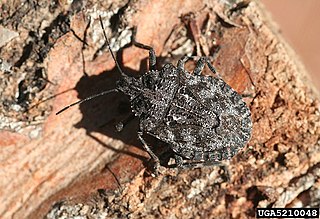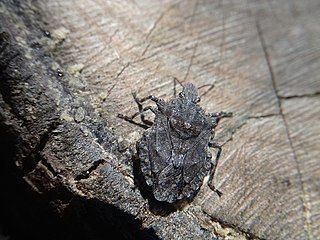
Brochymena is a genus of insects, sometimes known as the rough stink bugs. They belong to the shield bug family, and are easily confused with the similar-looking brown marmorated stink bug.
Pristimantis myops is a species of frog in the family Strabomantidae. It is endemic to Colombia and known from the Cordillera Occidental in Antioquia, Chocó, and Valle del Cauca Departments. The specific name myops is Greek meaning "near-sighted", in allusion to the interocular fold that resembles the bridge of a pair of glasses, as well as to the small size of these frogs, which forced the species describer to wear reading glass while collecting them.

The Inyo shrew is a species of shrew found in the western United States. It is light gray and white in color, with a narrow skull and small body size, very similar in appearance to the related dwarf shrew, but paler and not as large. It can be found in many different habitats, from rocky, mountainous regions to wetlands and riparian areas. Not much is known about its behavioral and reproductive habits. While barely studied, their population is believed to be stable and not under any threat.
Anthopotamus is a genus of hacklegilled burrower mayflies in the family Potamanthidae. There are at least four described species in Anthopotamus.
Anthopotamus myops is a species of hacklegilled burrower mayfly in the family Potamanthidae. It is found in southeastern Canada and the eastern United States.

Brochymena carolinensis is a species of stink bug in the family Pentatomidae. It is found in North America.

Halyini is a tribe of stink bugs in the family Pentatomidae. The tribe has been described as a "dumping ground" for numerous genera, many of which have been removed to other tribes. Databases like BugGuide, Integrated Taxonomic Information System, and Encyclopedia of Life record one genus and at least 20 described species in Halyini. More recent revisions such as that presented in Invasive Stink Bugs and Related Species (Pentatomoidea) (2018), indicate multiple genera in Halyini.

Brochymena sulcata is a species of stink bug in the family Pentatomidae. It is found in North America.
Aradus behrensi is a species of flat bug in the family Aradidae. It is found in North America.
Aneurus borealis is a species of flat bug in the family Aradidae. It is found in North America.
Brochymena chelonoides is a species of stink bug in the family Pentatomidae. It is found in Central America and North America.

Brochymena dilata is a species of stink bug in the family Pentatomidae. It is found in North America.
Brochymena cariosa is a species of stink bug in the family Pentatomidae. It is found in North America.

Brochymena arborea is a species of stink bug in the family Pentatomidae. It is found in Central America and North America.
Brochymena barberi is a species of stink bug in the family Pentatomidae. It is found in North America.
Brochymena punctata is a species of stink bug in the family Pentatomidae. It is found in North America.
Brochymena florida is a species of stink bug in the family Pentatomidae. It is found in North America.
Piazorhinus is a genus of true weevils in the beetle family Curculionidae. There are about eight described species in Piazorhinus.
Brochymena lineata is a species of stink bug in the family Pentatomidae. It is found in North America.
Brochymena hoppingi is a species of stink bug in the family Pentatomidae. It is found in North America.




